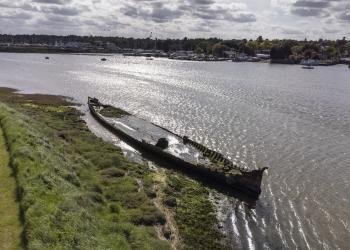
River Deben steamship hulk granted special protection
The iron hulk of the Lady Alice Kenlis, designed by the same shipwright as the Cutty Sark, has been granted protection by the Department for Culture, Media and Sport (DCMS) on the advice of Historic England.
The Lady Alice Kenlis was an iron steamship designed by Hercules Linton in 1867. He is the designer of the internationally renowned Cutty Sark, launched two years later in 1869. The Cutty Sark (now at Royal Museums Greenwich) was a state-of-the-art Victorian tea clipper. It was one of the fastest of its time, making the journey from Sydney to London by sail in 73 days. A clipper is a type of 19th century merchant sailing vessel, designed specifically for speed.
The Lady Alice Kenlis is important in our understanding of early iron ships and its relationship to the Cutty Sark offers an insight into Linton’s evolution of thought. Protection by scheduling will ensure that the hulk of the ship will be protected by law.
The hulk is situated on the National Trust’s Sutton Hoo estate but is not publicly accessible due to its location.
The remains of this particular ship are referred to as a ‘hulk’ rather than a shipwreck as there has been no wrecking event. Hulks are ships that have been abandoned, partially dismantled and then stripped of their fittings and permanently moored within intertidal areas, canals, estuaries and rivers.
Cllr Kay Yule, East Suffolk's cabinet member for Planning and Coastal Management, said:
"Anyone who uses the River Deben, or who has ever looked towards Sutton Hoo from the opposite quayside, will be very familiar with the sight, if not the name and history, of the Lady Alice Kenlis. She really is an established and striking feature of the landscape, so I’m thrilled that her historical significance is being recognised by Historic England with this designation.It will help to raise her profile and offer renewed protection as an important piece of our maritime past – and she becomes one of only two legally protected offshore vessels in the district, along with the wreck of an armed cargo ship off Dunwich Heath."
Arts and Heritage Minister Lord Parkinson of Whitley Bay said:
"The hulk of the Lady Alice Kenlis, resting in the River Deben, offers us an important insight into the work of Hercules Linton, who - as the designer of the Cutty Sark - became one of the most notable shipwrights of the nineteenth century. I am delighted that this important piece of our national heritage has been given protected status so that it can be preserved for generations to come."
Duncan Wilson, Chief Executive of Historic England said:
"Whilst only the rather ghostly remains of the Lady Alice Kenlis survive, it deserves protection as an important part of our seafaring history. Being able to see the hulk of the ship itself emerging from the intertidal zone of the River Deben is striking and unusual."
Angus Wainwright, Archaeologist at the National Trust said:
"Although we knew that the Lady Alice Kenlis was an interesting ship, we didn’t appreciate just how historically important she was. This is now our second scheduled ship at Sutton Hoo, as we also look after the site where the famous Anglo-Saxon burial ship was excavated in 1939. What’s interesting to me, is that the Sutton Hoo ship was nearly as long as its Victorian descendant, the Lady Alice Kenlis."
The ship was named after Alice Maria Hill, daughter of the Earl of Hillsborough, who married Lord Kenlis, a politician and the Earl of Bective in Ireland, to become Lady Alice Kenlis in 1867.
The vessel was built by J&R Swan in Maryhill, Glasgow and launched on 23 December 1867. The hull was heavily built in comparison to other iron ships of the time to allow it to be more easily loaded and unloaded in shallow waters. The ship was fitted with a two-cylinder 40 horse-power engine and rigged as a three masted schooner. A schooner is a type of vessel with two or more masts.
Serving as a cargo ship in 1868, it was used to carry cattle, goods and passengers between Northern Ireland, Scotland and England. It was briefly used as a ferry, later re-registered as the Holman Sutcliffe and converted into a suction dredger in 1913. The vessel continued as a dredger until it was partially dismantled in the late 1930s or early 1940s.
Hercules Linton (1836-1900) was a Scottish shipwright who worked as a surveyor for the Liverpool Underwriters’ Registry as a specialist on iron vessels. Linton went on to form the shipbuilding company Scott and Linton, which built a number of vessels, the most famous being the Cutty Sark, before going bankrupt in 1871.
The Missing Pieces Project: Uncover hidden histories and highlight overlooked stories
Although the hulk is not publicly accessible, we’d love you to add your story about the Lady Alice Kenlis to the Missing Pieces Project. It could be a photo, your information about the ship, or something you know about its historic fabric. You can add photos, drawings, audio, film, or text.
Everything you add is an important piece of the picture. And the more pieces of the picture we have, the better we can celebrate and protect what makes these places special.







